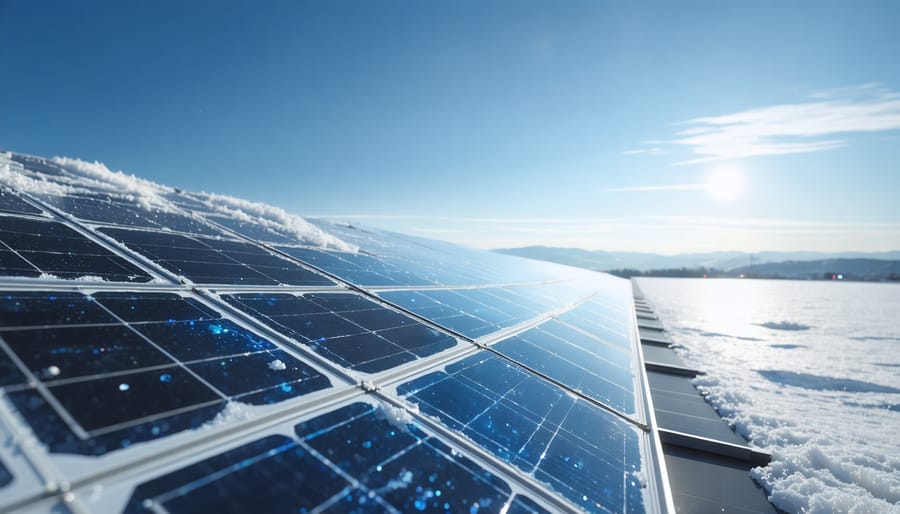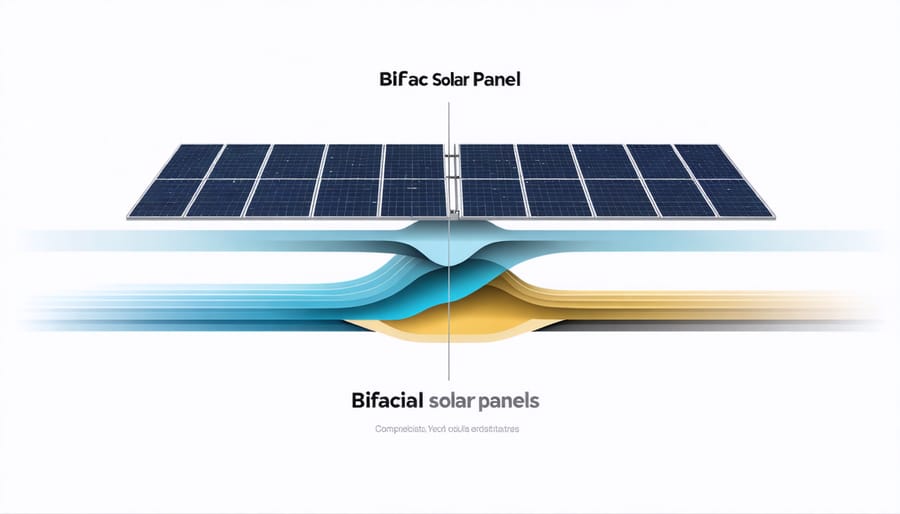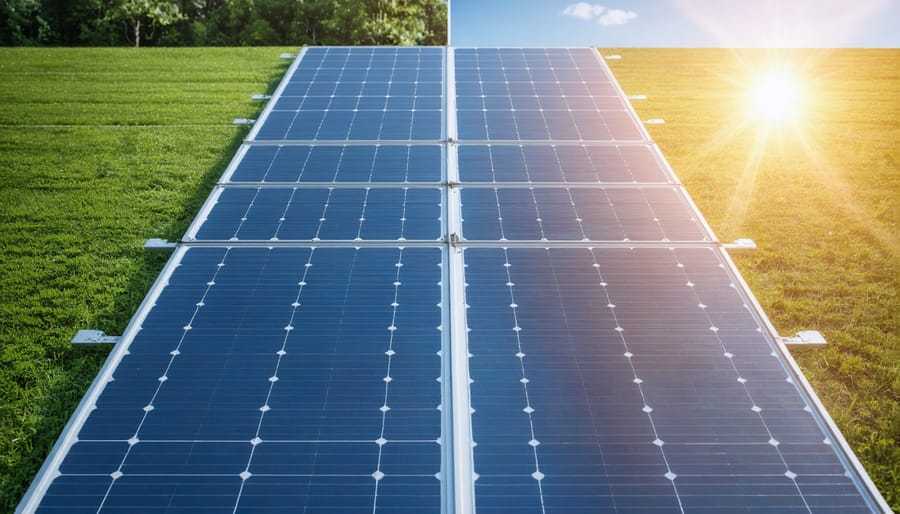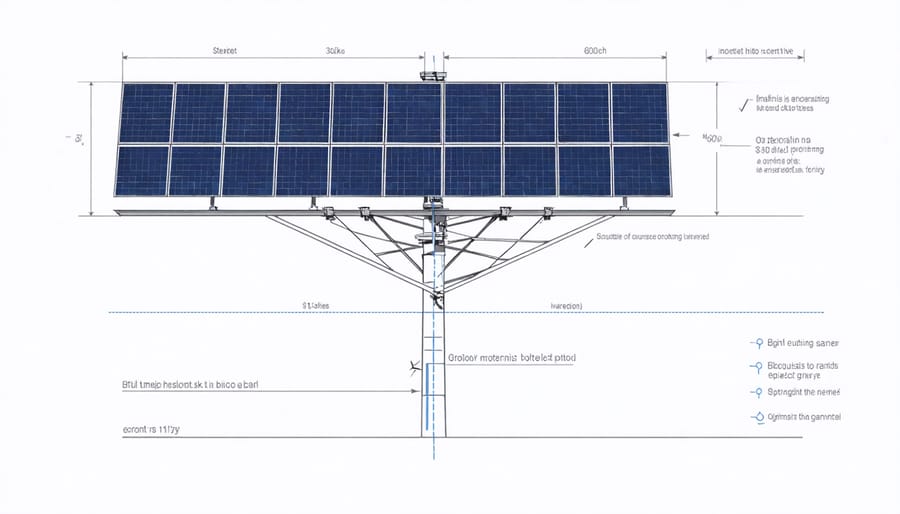Bifacial Solar Panels: The Technology That Captures Sunlight From Both Sides

Imagine capturing sunlight not just from above, but from every angle possible – that’s the revolutionary concept behind bifacial solar panels. These innovative photovoltaic modules generate power from both their front and rear surfaces, marking a significant leap forward in solar energy efficiency. While traditional solar panels only harvest light from one side, bifacial technology transforms previously wasted reflected light into valuable energy, potentially increasing power generation by up to 30%.
In Europe’s rapidly evolving renewable energy landscape, bifacial solar panels represent the next generation of solar technology, offering enhanced performance particularly in regions with high surface reflectivity like snow-covered areas or white-painted roofs. For businesses and homeowners seeking to maximize their solar investment, these double-sided panels provide a compelling solution that combines cutting-edge technology with practical energy generation benefits.
As we delve deeper into this technology, we’ll explore how bifacial panels work, their advantages, and why they might be the perfect choice for your sustainable energy future.
What Makes Bifacial Solar Panels Different?
The Dual-Sided Design
Bifacial solar panels represent a significant evolution in the core components of solar panels, featuring photovoltaic cells on both the front and rear surfaces. Unlike traditional modules, these innovative panels utilise a transparent backsheet or glass-on-glass design that allows them to capture light from both directions. The front side functions like a conventional solar panel, directly absorbing sunlight, while the rear side captures reflected light from surrounding surfaces such as ground cover, nearby buildings, or snow.
The dual-sided design typically incorporates high-quality solar cells sandwiched between two layers of highly transparent glass, ensuring optimal light transmission and durability. Each side is protected by anti-reflective coatings and specialised encapsulation materials that enhance light absorption while providing robust weather protection. This sophisticated construction enables the panels to harness additional energy from ambient and reflected light, potentially increasing overall energy yield by 5-30% compared to traditional single-sided panels.

Transparent Backsheet vs. Glass-Glass Construction
Bifacial solar panels are available in two main material configurations: transparent backsheet and glass-glass construction. The transparent backsheet design features a traditional glass front with a specialised transparent polymer backsheet that allows light to pass through. This configuration offers a lightweight solution while maintaining good bifacial performance and durability.
Glass-glass modules, on the other hand, sandwich the solar cells between two layers of tempered glass. This construction provides superior protection against environmental factors and typically offers a longer lifespan of up to 30 years. While slightly heavier, glass-glass panels demonstrate excellent durability and often achieve higher bifacial gains due to better light transmission through the rear surface.
European manufacturers have particularly embraced glass-glass technology, as it aligns with the region’s focus on long-term sustainability and reduced maintenance requirements. The choice between these configurations often depends on specific project requirements, including installation location, weight constraints, and local weather conditions.
Key Materials in Bifacial Solar Panels

Solar Cell Materials
Modern bifacial solar panels utilize several advanced solar cell technologies to maximize energy generation from both sides. The most common technology is PERC (Passivated Emitter and Rear Cell), which features specially designed rear surfaces that capture reflected light effectively. PERC cells typically achieve bifaciality factors of 65-75%, making them a reliable choice for many European installations.
Heterojunction Technology (HJT) represents another significant advancement in bifacial solar materials. HJT cells combine crystalline silicon with thin-film technology, resulting in superior temperature coefficients and impressive bifaciality factors of up to 90%. This makes them particularly effective in varied European climates, from the Mediterranean south to the Nordic regions.
TOPCon (Tunnel Oxide Passivated Contact) technology is gaining prominence in bifacial applications, offering enhanced efficiency through improved electron transport and reduced recombination losses. These cells typically achieve bifaciality factors of 80-85%, positioning them as a premium option for high-performance installations.
The choice of glass encapsulation also plays a crucial role. High-transmission, anti-reflective glass is used on both sides to maximize light capture while ensuring durability. Many manufacturers now employ specialized EVA (Ethylene Vinyl Acetate) or POE (Polyolefin Elastomer) encapsulants that maintain transparency and reliability throughout the panel’s lifetime.
Encapsulation and Protection Materials
The durability and performance of bifacial solar panels heavily rely on their encapsulation and protection materials. These crucial components shield the solar cells while maximising light transmission and ensuring long-term reliability in various weather conditions.
The most commonly used encapsulation material in European installations is ethylene vinyl acetate (EVA), which provides excellent transparency and UV resistance. This polymer creates a protective seal around the solar cells, preventing moisture ingress while allowing maximum light penetration to both front and rear surfaces.
For the outer protective layers, manufacturers typically employ high-quality tempered glass on both sides of bifacial panels. This dual-glass construction offers superior protection compared to traditional backsheet designs, with enhanced durability against environmental stresses common in European climates. The glass layers are typically treated with anti-reflective coatings to optimise light capture and feature self-cleaning properties that maintain performance in dusty conditions.
Some innovative designs incorporate specialized edge sealants and frame materials that prevent delamination and water ingress while allowing for thermal expansion. These materials are rigorously tested to withstand temperature fluctuations between -40°C and +85°C, ensuring reliable operation throughout the year.
The combination of these protection materials typically results in warranties extending to 30 years, demonstrating the robust nature of modern bifacial panel construction and its suitability for long-term energy production.
Performance and Efficiency Factors
Bifaciality Factor
The bifaciality factor is a crucial measure that indicates how effectively a solar panel’s rear side generates energy compared to its front side. This ratio typically ranges from 60% to 90%, depending on the materials used in panel construction. High-quality glass-glass modules often achieve bifaciality factors around 85%, while panels using white backsheets generally reach about 65-70%.
The choice of materials significantly impacts rear-side performance. Glass-glass configurations offer superior bifaciality due to their transparent nature and durability, allowing more light to reach the solar cells from both directions. Traditional backsheet materials, while less expensive, can limit rear-side generation due to their partial opacity.
Cell technology also plays a vital role. PERC (Passivated Emitter and Rear Cell) and n-type cells typically deliver higher bifaciality factors compared to conventional p-type cells. The cell architecture and metallisation pattern on both sides influence how effectively the panel converts reflected light into electricity.
For optimal performance, manufacturers carefully balance material costs with efficiency gains, considering factors like weight, durability, and local installation conditions.
Durability and Longevity
Bifacial solar panels are engineered for exceptional durability, typically featuring high-quality tempered glass on both sides, which provides superior protection against environmental stresses. This dual-glass construction offers significantly better resistance to potential induced degradation (PID) compared to traditional single-sided panels, contributing to their extended operational lifespan of 30+ years.
The robust design of bifacial panels makes them particularly resilient to harsh weather conditions common across European climates. The glass-glass structure prevents moisture ingress and reduces the risk of micro-cracks, which are common failure points in conventional panels. Additionally, the elimination of the traditional backsheet removes a potential point of degradation, enhancing overall panel reliability.
Most bifacial panels come with warranties extending to 25-30 years, reflecting manufacturer confidence in their longevity. Performance degradation rates are typically lower than conventional panels, with annual degradation rates often below 0.4%. This superior durability translates into sustained energy production and better return on investment over the system’s lifetime, making them particularly attractive for long-term energy projects in both commercial and residential applications.

Installation Considerations for Maximum Performance
To maximize the performance of bifacial solar panels, proper installation is crucial. Unlike traditional panels, bifacial modules require specific consideration of their unique dual-sided nature. Following established solar panel installation guidelines while accounting for these special requirements will ensure optimal energy generation.
Height and elevation play a vital role in bifacial performance. Installing panels at least 1 meter above the surface allows sufficient light reflection to reach the rear side. The optimal elevation may vary depending on your location and specific installation conditions, but maintaining adequate clearance is essential for maximizing bifacial gain.
Surface reflectivity beneath the panels significantly impacts rear-side performance. Light-colored surfaces like white gravel, light-colored roof materials, or even snow can increase energy yield by up to 30%. Consider installing reflective materials or painting surfaces white where appropriate to enhance rear-side generation.
Row spacing requires careful planning to prevent inter-row shading and optimize rear-side exposure. Generally, wider spacing between rows (pitch-to-height ratio of 2:1 or greater) provides better results for bifacial installations compared to traditional monofacial setups.
Mounting systems should be designed to minimize rear-side shading from support structures. Transparent or slim-profile mounting solutions can help maximize the amount of reflected light reaching the panel’s rear surface. Additionally, ensuring proper tilt angles (typically between 20-40 degrees in European installations) optimizes both front and rear-side energy capture throughout the year.
Regular maintenance of the surrounding area, including vegetation control and surface cleaning, helps maintain optimal reflectivity conditions for sustained performance.
The selection of materials in bifacial solar panels plays a pivotal role in shaping the future of solar energy technology. As we’ve explored, the careful combination of high-quality glass, advanced cell technologies, and robust encapsulation materials directly influences both performance and longevity. These material choices not only determine the panel’s ability to capture light from both sides but also impact its durability and overall energy yield.
For European markets, where sustainability and efficiency are paramount, bifacial panels represent a significant step forward in solar technology. Their enhanced energy capture capabilities, particularly in regions with varying light conditions, make them an increasingly attractive option for both commercial and residential applications. The innovation in material science continues to drive improvements in bifacial technology, leading to higher efficiency rates and more cost-effective solutions.
Looking ahead, the role of bifacial panels in advancing solar technology cannot be understated. As manufacturers continue to refine material selections and improve production processes, we can expect to see even greater advances in performance and reliability. This ongoing evolution in material technology is essential for meeting Europe’s ambitious renewable energy goals and creating a more sustainable future for generations to come.
Leave a Reply